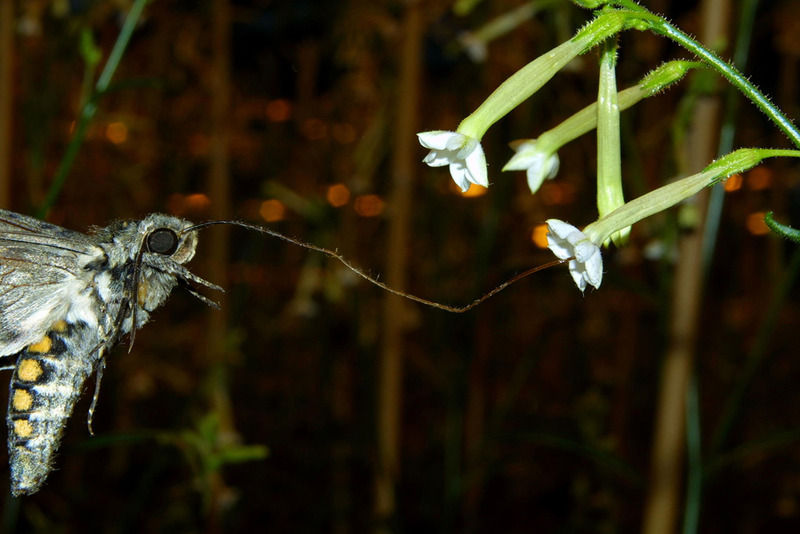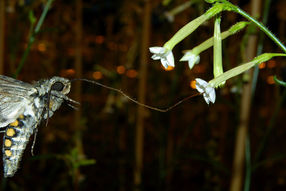Molecular Messages from the Antennae
Scientists assemble genes involved in regulating olfaction in the antennae of a moth
Insects use their antennae for smelling and thus for locating resources in their environment. In an online first article published now, Max Planck researchers present the first complete analysis of genes involved in antennal olfaction of the tobacco hornworm Manduca sexta. Approximately 70 different receptors expressed in some 100 000 neurons allow these moths to detect a large number of odors and to perform relevant odor-guided behaviors. This is the first more or less complete antennal transcriptome characterized in a non-model insect.

With the help of its antennae this night-active tobacco hornworm (Manduca sexta) has been able to locate wild tobacco flowers by smell and is now enjoying the nectar.
© MPI for Chemical Ecology/Danny Kessler

Tissue section of a male Manduca sexta antenna. Red and green areas are evidence for transcripts of two different odorant receptors (scale: 50 micrometers).
MPI for Chemical Ecology/Christopher König


Insects have a highly sensitive sense of smell. Extremely low concentrations of odor molecules in the air are sufficient to be detected by receptor neurons on their antennae. Specific proteins, so-called receptor proteins, expressed in these neurons recognize the odors. The odor molecules bind to the receptors and produce chemical and electrical signals that are processed in the insect brain and eventually affect the insect’s behavior.
Apart from the receptors, further proteins involved in olfaction, including enzymes and chemosensory proteins, come into play. Based on these molecular principles, all insects follow their innate and elementary survival formula: finding food, recognizing mates, and − in case of females − identifying adequate oviposition sites that guarantee nutritious and easily digestible food for their offspring.
Moths (Lepidotera) are popular research objects in addition to fruit flies. The genome of the silkworm Bombyx mori has been fully sequenced; however, this insect has been domesticated by humans for thousands of years, therefore its native conspecifics cannot be found anymore. On the other hand, the “habits” of the tobacco hornworm Manduca sexta, a moth species native to North America, have been the subject of intense physiological investigations to study the insect olfactory system, and recently also because its host plant, wild tobacco Nicotiana attenuata, has advanced to an important model plant in ecological research.
Genetic analysis of the Manduca sexta antennae closes a gap in the search after the insect’s odor-directed behavior: The release of stress-induced odor molecules by tobacco plants is well studied, as is the pollination of the flowers by the moths. “But how does the plant odor – metaphorically speaking − end up in the insect’s brain?” asks Bill Hansson, director of the Department of Evolutionary Neuroethology founded in 2006 at the Max Planck Institute.
The scientists identified the antennal transcriptome as an important basis for studying olfactory function of the insect and sequenced active genes in the antennae completely. Additionally, they determined the amount of individual messenger RNAs (mRNAs) that belong to each gene. Sequence information which involved more than 66 million nucleotides was analyzed. Basically, the results can be summarized as follows: i.) Manduca sexta has 18 specific odorant binding proteins (OBPs) and 21 chemosensory proteins (CSPs). ii.) Manduca males possess 68 different odorant receptors, each expressed in a specific type of neuron coupled to a corresponding glomerulus in the brain, whereas females have 70 of these “response units”. Most of the receptors could be identified in the course of these studies. iii.)
69% of the transcripts could not be annotated to a specific gene function: their role in the antennae is so far unknown. Presumably there are many more neural mechanisms of stimulus processing in the antennae that are yet to be elucidated. Some mRNAs imply that there is intense enzymatic activity, esterases for instance; there is also a larger amount of transcripts that regulate gene expression, indicating that the antenna can adapt to new situations by gene regulation. iv.) Antennal genetics do not seem particularly complex: For comparison: there are almost twice as many active genes in the larval midgut as in the antennae of an adult moth. Only 348 genes are exclusively expressed in males; females, after all, claim 729 genes as their own. This may be due to their life sustaining formula to lay their fertilized eggs in ideal places, such as wild tobacco leaves, where young larvae can feed.





















































